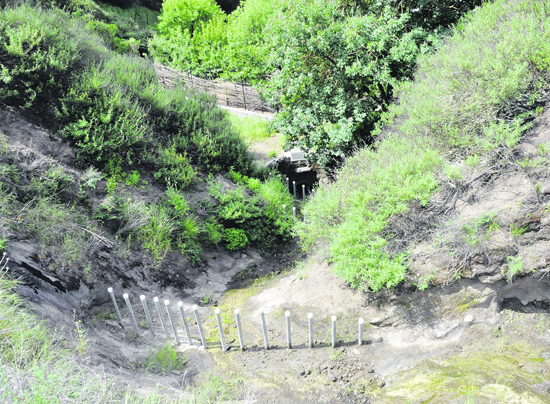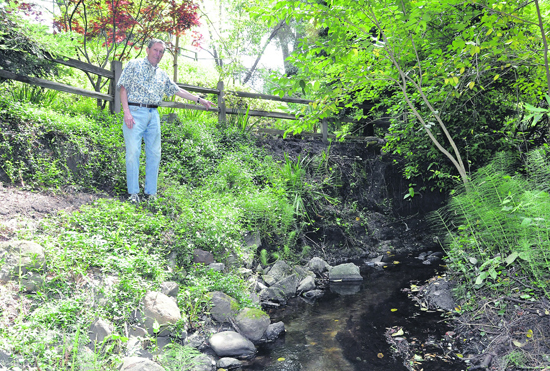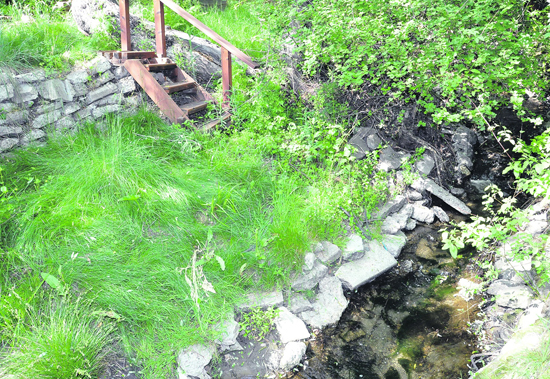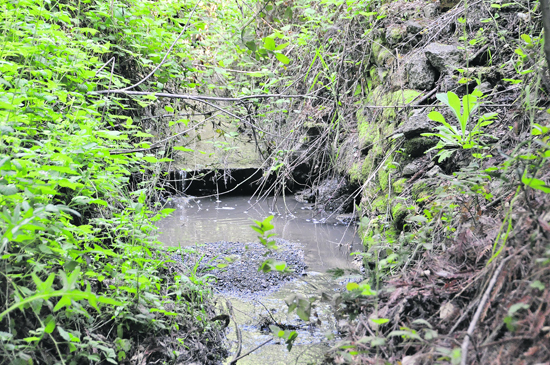 | | | Wild creek coming down Briones toward Virginia and Tom Steubers' home. Photos Andy Sckeck
| | | | | | Orinda resident Martin Spittler probably described it best, "Creeks are really 'Beauty and the Beast' for most homeowners."
 Beauty for the sylvan quality of the environment they nurture, but potential beasts if storms overwhelm local drainage systems. A creek in a back yard can be a wonderful feature, but it is part of a natural or engineered drainage system that the individual homeowner rarely controls. Still, most of these homeowners would choose their piece of property again.
Beauty for the sylvan quality of the environment they nurture, but potential beasts if storms overwhelm local drainage systems. A creek in a back yard can be a wonderful feature, but it is part of a natural or engineered drainage system that the individual homeowner rarely controls. Still, most of these homeowners would choose their piece of property again.
 Many Lamorinda residents live near a creek - some a permanent feature that creates challenges, others ephemeral subsidiaries that run in winter and are often less trouble. Those who live close to the open space that surrounds Lamorinda have to take charge of potential hazards.
Many Lamorinda residents live near a creek - some a permanent feature that creates challenges, others ephemeral subsidiaries that run in winter and are often less trouble. Those who live close to the open space that surrounds Lamorinda have to take charge of potential hazards.
 When Tom and Virginia Steuber bought their Lafayette home that borders Briones Regional Park, they knew that the beautiful natural creek meandering down from the surrounding hills could flood their property. They hired an engineering firm to build a collection and piping system large enough to catch the worst storms.
When Tom and Virginia Steuber bought their Lafayette home that borders Briones Regional Park, they knew that the beautiful natural creek meandering down from the surrounding hills could flood their property. They hired an engineering firm to build a collection and piping system large enough to catch the worst storms.
 What they did not anticipate was that mud and brush would come down with the water, instantly clogging the drain entrance. "I will always remember that morning of New Year's Eve in 2005 when we woke up and discovered our entire backyard and two-thirds of the swimming pool buried under four to 18 inches of mud," says Steuber. Since then, her gardener installed rows of poles that catch the debris along the way.
What they did not anticipate was that mud and brush would come down with the water, instantly clogging the drain entrance. "I will always remember that morning of New Year's Eve in 2005 when we woke up and discovered our entire backyard and two-thirds of the swimming pool buried under four to 18 inches of mud," says Steuber. Since then, her gardener installed rows of poles that catch the debris along the way.
 To balance the tempestuous nature of the creek in the back of her property, Steuber created a peaceful artificial creek in front, with a pond. The serene atmosphere of that decor is very close to what Zoe and Jim Klippert experience in Moraga with a garden bordering an ephemeral creek.
To balance the tempestuous nature of the creek in the back of her property, Steuber created a peaceful artificial creek in front, with a pond. The serene atmosphere of that decor is very close to what Zoe and Jim Klippert experience in Moraga with a garden bordering an ephemeral creek.
 "It's never gone any higher than the base of the little redwood," says Klippert pointing to a young tree in the lower tier of the bank of the creek. Their creek is quite tame; it drains some adjacent open space and joins shortly after the Klipperts' property to the larger Moraga Creek.
"It's never gone any higher than the base of the little redwood," says Klippert pointing to a young tree in the lower tier of the bank of the creek. Their creek is quite tame; it drains some adjacent open space and joins shortly after the Klipperts' property to the larger Moraga Creek.
 In this setting, property owners own both sides of the creek. Forty years ago, their neighbor decided that it was wasted space and built a culvert with the advice of the United States Army Corps of Engineers, and flattened the whole backyard; a rare move for someone with a creek, but that has proven quite harmless to the property.
In this setting, property owners own both sides of the creek. Forty years ago, their neighbor decided that it was wasted space and built a culvert with the advice of the United States Army Corps of Engineers, and flattened the whole backyard; a rare move for someone with a creek, but that has proven quite harmless to the property.
 This radical way of controlling a creek is rare for individual homeowners, but according to Spittler, it was done extensively when the cities were developed. He still remembers the Orinda creeks he played in with his friends that now run through concrete tunnels under shopping centers or freeways.
This radical way of controlling a creek is rare for individual homeowners, but according to Spittler, it was done extensively when the cities were developed. He still remembers the Orinda creeks he played in with his friends that now run through concrete tunnels under shopping centers or freeways.
 As far as homeownership is concerned, maintenance of the creeks mostly means stabilizing the banks. "You can see that where the creek turns, the outside bank gets eroded much more quickly," says Lafayette resident Al Steuber (Virginia's father-in-law) pointing to a portion of the year-round creek that borders his property. The natural tendency of the creek would be to go straight, so especially when the volume of water is high, consistently hitting that curb slowly erodes the side. Planting native trees so roots hold the bank and installing large rocks on the side are some things that help. That's what Klippert did and in the process, he opened a beautiful area in his backyard.
As far as homeownership is concerned, maintenance of the creeks mostly means stabilizing the banks. "You can see that where the creek turns, the outside bank gets eroded much more quickly," says Lafayette resident Al Steuber (Virginia's father-in-law) pointing to a portion of the year-round creek that borders his property. The natural tendency of the creek would be to go straight, so especially when the volume of water is high, consistently hitting that curb slowly erodes the side. Planting native trees so roots hold the bank and installing large rocks on the side are some things that help. That's what Klippert did and in the process, he opened a beautiful area in his backyard.
 Once nature is stabilized and hopefully controlled, the fun part of integrating the natural water feature into the garden begins. The Prestons in Moraga had a non-accessible bank riddled with ivy and blackberry. "We didn't 'discover' the creek until we were remodeling in 1999," remembers Bobbie Preston. From the start the Prestons wanted to restore and use their side of the creek the natural way.
Once nature is stabilized and hopefully controlled, the fun part of integrating the natural water feature into the garden begins. The Prestons in Moraga had a non-accessible bank riddled with ivy and blackberry. "We didn't 'discover' the creek until we were remodeling in 1999," remembers Bobbie Preston. From the start the Prestons wanted to restore and use their side of the creek the natural way.
 "We had 30-plus truckloads of tree chips dumped on the hillside to create a plantable area," she says. "The Watershed Creeks Council helped us replant the creek side with natives such as nine-bark, flowering currant and willow, and we also added Cleveland sage, and California fuchsia." Tom Preston built the stairs, terraces and decks that are used by the three generations who come to their home. "He used recycled wood from our neighbors' fence for the terrace, bricks from our old fireplace for the path," says Preston. The result is charming.
"We had 30-plus truckloads of tree chips dumped on the hillside to create a plantable area," she says. "The Watershed Creeks Council helped us replant the creek side with natives such as nine-bark, flowering currant and willow, and we also added Cleveland sage, and California fuchsia." Tom Preston built the stairs, terraces and decks that are used by the three generations who come to their home. "He used recycled wood from our neighbors' fence for the terrace, bricks from our old fireplace for the path," says Preston. The result is charming.
 What Spittler did with his ephemeral creek is equally appealing, offering to the eye and the meditative visitor a natural oak and pine woodland where local wildlife loves to come.
What Spittler did with his ephemeral creek is equally appealing, offering to the eye and the meditative visitor a natural oak and pine woodland where local wildlife loves to come.
 The Lebermans in Orinda also rave about the uniqueness of having a creek on their property. Their challenge is that they must cross the creek and a bridge shared by three homes to reach their house. "We rebuilt it together five years ago," explains Susan Leberman. "It was quite a project, but you don't want to end up with your car at the bottom of the creek." The Libermans have a second pedestrian bridge on their property.
The Lebermans in Orinda also rave about the uniqueness of having a creek on their property. Their challenge is that they must cross the creek and a bridge shared by three homes to reach their house. "We rebuilt it together five years ago," explains Susan Leberman. "It was quite a project, but you don't want to end up with your car at the bottom of the creek." The Libermans have a second pedestrian bridge on their property.
 All these homeowners agree that having a natural water feature in your yard is as wonderful as the abundance of wildlife that comes with it - whether they are owls and bats, or deer and raccoons.
All these homeowners agree that having a natural water feature in your yard is as wonderful as the abundance of wildlife that comes with it - whether they are owls and bats, or deer and raccoons.
 D4
D4

|



